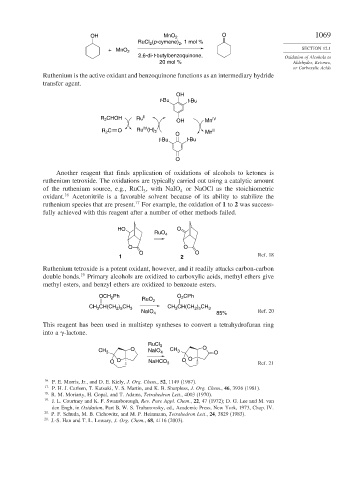Page 1093 - Advanced Organic Chemistry Part B - Reactions & Synthesis
P. 1093
OH MnO 2 O 1069
RuCl (p-cymene) , 1 mol %
2
2
SECTION 12.1
+ MnO 2
2,6-di-t-butylbenzoquinone, Oxidation of Alcohols to
20 mol % Aldehydes, Ketones,
or Carboxylic Acids
Ruthenium is the active oxidant and benzoquinone functions as an intermediary hydride
transfer agent.
OH
t-Bu t-Bu
R CHOH Ru II OH Mn IV
2
IV
R C O Ru (H) 2 Mn II
2
O
t-Bu t-Bu
O
Another reagent that finds application of oxidations of alcohols to ketones is
ruthenium tetroxide. The oxidations are typically carried out using a catalytic amount
of the ruthenium source, e.g., RuCl , with NaIO or NaOCl as the stoichiometric
3
4
oxidant. 16 Acetonitrile is a favorable solvent because of its ability to stabilize the
17
ruthenium species that are present. For example, the oxidation of 1 to 2 was success-
fully achieved with this reagent after a number of other methods failed.
HO O
RuO 4
O O
O O
1 2 Ref. 18
Ruthenium tetroxide is a potent oxidant, however, and it readily attacks carbon-carbon
double bonds. 19 Primary alcohols are oxidized to carboxylic acids, methyl ethers give
methyl esters, and benzyl ethers are oxidized to benzoate esters.
OCH Ph O CPh
2
2
RuO 2
CH 3 CH(CH 2 ) 5 CH 3 CH 3 CH(CH 2 ) 5 CH 3
NaIO 4 85% Ref. 20
This reagent has been used in multistep syntheses to convert a tetrahydrofuran ring
into a -lactone.
RuCl 3
CH 3 O NaIO 4 CH 3 O O
O O NaHCO 3 O O Ref. 21
16
P. E. Morris, Jr., and D. E. Kiely, J. Org. Chem., 52, 1149 (1987).
17 P. H. J. Carlsen, T. Katsuki, V. S. Martin, and K. B. Sharpless, J. Org. Chem., 46, 3936 (1981).
18 R. M. Moriarty, H. Gopal, and T. Adams, Tetrahedron Lett., 4003 (1970).
19
J. L. Courtney and K. F. Swansborough, Rev. Pure Appl. Chem., 22, 47 (1972); D. G. Lee and M. van
den Engh, in Oxidation, Part B, W. S. Trahanovsky, ed., Academic Press, New York, 1973, Chap. IV.
20 P. F. Schuda, M. B. Cichowitz, and M. P. Heinmann, Tetrahedron Lett., 24, 3829 (1983).
21
J.-S. Han and T. L. Lowary, J. Org. Chem., 68, 4116 (2003).

